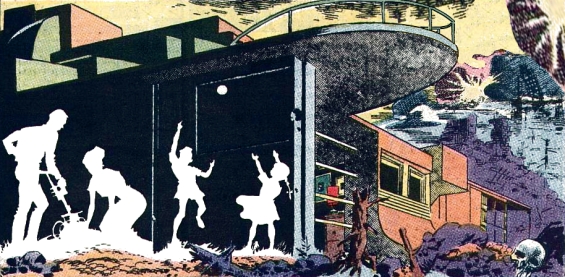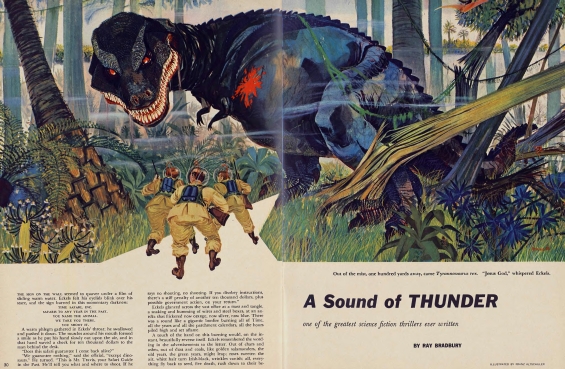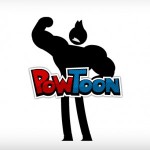Literature Study: Ray Bradbury
Ray Bradbury Links:
Biography
Bradbury Media
Wikipedia
Comments on Books and His Writing
“There Will Come Soft Rains” (May 6, 1950) – Ray Bradbury – Short Story
Alternate Assignment Addition: Click HERE for ideas
Audio Version:
Leonard Nimoy reads “There Will Come Soft Rains”
Video Versions:
“There Will Come Soft Rains” – CaptainVideo54
There Will Come Soft Rains” – SteveBradshaw412
“There Will Come Soft Rains” – Thugie
“There Will Come Soft Rains” – Budet Laskovyj Dozhd
“There Will Come Soft Rains” – Inspirations Analysis
“There Will Come Soft Rains” – Sara Bliesener
Five Ways of Going Beyond the Text of “There Will Come Soft Rain” To Show Perception
1. Our Modern World – Intelligent ‘smart’ houses: did Bradbury predict reality?
a) Check out the virtual tour of Bill Gates’s house HERE
b) Comment on the similarities and differences to the house in the story. (Think: Venn Diagram)
c) Check out the latest technology trends HERE and HERE
(e.g. As per many reports,Google is expected to start selling eyeglasses that will project information, entertainment, and advertisements onto the lenses. These glasses will have the combined features of virtual reality and augmented reality.)
> > TASK: Comment on Ray Bradbury’s prescience and on how technology is influencing the way we live – for better or worse.
———————————————————————————
2. Nuclear warfare – where are we?
a) How close is the world to nuclear annihlation? Find out the lastest .
* nuclear warfare capacity
* Gizmodo
* New Zealand
>> TASK: Explain the relevance of the story to the real world nuclear scenario.
———————————————————————————
3. The Writer’s View
Although he is often described as a science fiction writer, Bradbury does not box himself into a particular narrative categorization. Here are five comments he has made on his writing:
-
First of all, I don’t write science fiction. I’ve only done one science fiction book and that’s Fahrenheit 451 based on reality. Science fiction is a depiction of the real. Fantasy is a depiction of the unreal. So Martian Chronicles is not science fiction, it’s fantasy. It could happen, you see? That’s the reason it’s going to be around a long time – because it’s a Greek myth and myths have staying power.
-
People are afraid of fantasy. A lot of intellectuals think science fiction is trivial. And it’s pivotal. People are walking around the streets with phones to their heads talking to someone ten feet away. We’ve killed two million people with automobiles. We’re surrounded by technology and the problems created by technology, and science fiction isn’t important?
-
I have to write these books and help change the future.
-
I was born a collector of metaphors. Metaphors are the center of life. I’m deeply influenced by Greek and Roman mythology. The colorful stuff, anything magical. I’ve had all this stuff in my head from the age of three on.
-
I’ve never set out to predict. I just write what later seems to evolve and be true.
>> TASK: Choose at least ONE comment/quote from above and discuss a connection to the story.
———————————————————————————
4. Sources of Inspiration
There Will Come Soft Rains is a 12-line poem by Sara Teasdale in her collection Flame and Shadow, published in 1920. The subject of the poem imagines nature reclaiming the earth after humanity has been wiped out by a war (line 7) The poem has six stanzas, each made up of a rhyming couplet.
[poem can be found in the story]
>> TASK: Explain the links between the poem and Bradbury’s story. Also note which war she must have had in mind when she wrote the poem (pay attention to the year it was written)
———————————————————————————
5. Historical Events and Technology – The Aftermath of World War II
Bradbury wrote There Will Come Soft Rains in the early 1950’s. The memory of World War II was fresh in the peoples’ minds, particularly the atomic bombing of Hiroshima and Nagasaki, Japan, in August, 1945, which brought the war to an end. Though the Allies had won, an increasing tension arose between the United States and the U.S.S.R., and soon a nuclear buildup known as the Cold War began. President Dwight Eisenhower, a war hero, warned of the rising military-industrial complex it took to support the Cold War.
The story portrays a scene of obliteration, in which the human race has been destroyed by a nuclear bomb. The fear of the devastating effects of nuclear force was very applicable to the time period of the 1950’s. The world was still recovering from the effects of World War II and events, such as the dropping of atomic bombs in Japan still seemed recent. In 1945, the United States released a nuclear bomb over the city of Hiroshima that destroyed nearly everything in the city. Three days later, Nagasaki was also bombed. Hundreds of thousands of people were killed in these bombings, either from direct impact of the deadly effects of radiation that killed them within a few years of the incident. Even thought the war ended shortly after these events, the fear of retaliation and the increasing focus on the development of nuclear weapons by many military powers world-wide, produced fear in the minds of people. After the war, tension increased between the two major military powers of the time, the U.S.S.R. and the The United States, culminating in the Cold War. This era was also a time of uncertainty, and the idea of being bombed with a nuclear weapon was a daily fear.
1951: The first thermonuclear device is detonated by the USA in the mid-Pacific. The island atoll of Enjwetok is obliterated by the blast. Few precautions are taken to protect nearby inhabitants from radiation poisoning.
1997: A significant percentage of the USA’s electricity is generated by nuclear power plants, despite several near meltdowns in the last few decades, including mishaps at Three Mile Island, Pennsylvania, and Monroe, Michigan.
>>TASK: Comment on the relationship between the following historical and political context and Bradbury’s story.
———————————————————————————————————————————
“The Sound of Thunder” – Ray Bradbury – Short Story
——————————————————————————————————————————–
“All Summer in a Day” – Ray Bradbury – Short Story
———————————————————————————————————————————————————

“The Veldt” – Ray Bradbury (1950)- Short Story
Listen to Leonard Nimoy read the “The Veldt”
Instructions:
1. Go to Google Classroom and respond to Assignment 1: The Veldt – Text Opener.
2. Before you read the short story “The Veldt” by Ray Bradbury, watch the music video “The Veldt” by Deadmau5. Use the corresponding Assignment 2 for this portion of the lesson, and complete the section Before Reading the Story, sharing reflections and making predictions based on the music video. Feel free to follow along with the lyrics to the song.
3. Watch Background of the 1950’s
4. Assignment 3 -Use the Discussion Questions to guide your reading before, during, and after you Read “The Veldt” by Ray Bradbury (1950) and complete the assignment for class.
5. Rewatch the Music Video and complete the section on Assignment 2 – After Reading the Story
6. Complete Assignments 3- 8 on Google Classroom. Here we will be analyzing characters and themes.
7. Click HERE for more themes. With a partner, select one theme (either from those studied in class or in the list above) you feel is the most fitting to describe the story. Find evidence in the text to support your claim.










